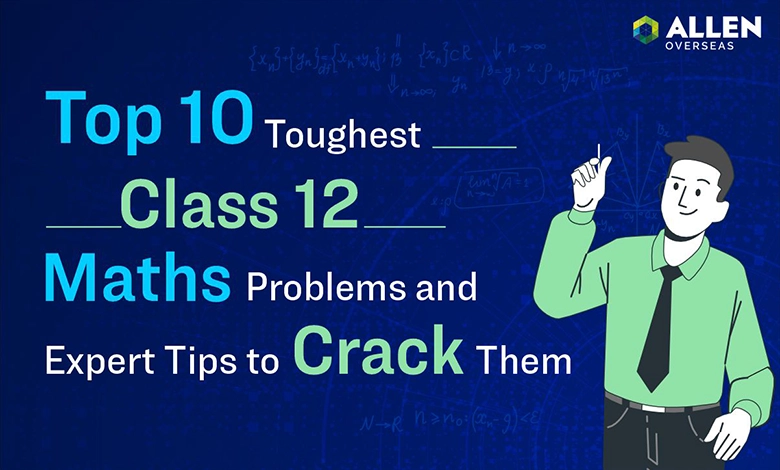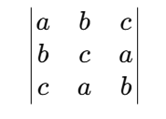- Call Us :
- Mail Us :
- Request a Call



Mastering Class 12 Math is one of the biggest academic milestones for students aiming for top scores in board exams and entrance tests like JEE Main, JEE Advanced, BITSAT, etc.. While solving basic textbook problems might seem manageable, the real challenge begins when you’re faced with advanced, tricky, and conceptual problems that truly test your skills.
If you’re wondering how to tackle the most difficult questions from chapters like Integration, 3D Geometry, Probability, and Differential Equations, you’re in the right place.
In this blog, we have handpicked the 10 most challenging Class 12 Maths problems, along with proven expert tips and strategies to help you solve them step-by-step.
Whether you’re a CBSE, ISC, or international curriculum student, these insights will give you the edge you need to excel.
Before diving in, it’s important to know why certain problems are more difficult:
If you’re aiming for top scores or preparing for exams like JEE Main/Advanced, CBSE, ISC, or IB, this list will help you stay ahead.
Evaluate : 
Why it’s hard:
It’s not straightforward and requires using integration by parts, which many students misuse.
Tip to Solve:
Use
![]()
Let ![]() The correct choice of u is critical here.
The correct choice of u is critical here.
Find the equation of the normal to the curve
y = x³−3x+2 at the point where the tangent is horizontal.
Why it’s hard:
You have to differentiate, find where the slope is zero, and then plug that into the normal formula.
Tip to Solve:
Find the shortest distance between the lines
![]()
Why it’s hard:
You need to understand vector operations and geometric intuition—many students confuse parallel with skew lines.
Tip to Solve:
Use the formula:

Determine the value of 𝑘 for which the function

is continuous and differentiable at x=1.
Why it’s hard:
You must match both the function values and derivatives from either side—a classic board trap.
Tip to Solve:
![]()
A factory has 3 machines producing bulbs. Machine A produces 30% of total, B 45%, and C 25%. The probability of producing a defective bulb is 1% for A, 2% for B, and 3% for C. A bulb is chosen at random and found defective. What is the probability it came from Machine B?
Why it’s hard:
Students struggle with Bayes’ Theorem, especially with conditional probability.
Tip to Solve:
Use: 
Break it down step by step and use a probability tree if needed.
Prove that the triangle with vertices represented by complex numbers
![]()
![]()
Why it’s hard:
You must visualize complex numbers as vectors and use modulus as length.
Tip to Solve:
Calculate the modulus of sides (i.e., distances between points) using
![]()
Compare them to prove two are equal.
Maximize Z=3x+5y subject to
![]()
Why it’s hard:
Plotting inequalities and identifying feasible regions is time-consuming and error-prone.
Tip to Solve:
Graph each inequality clearly
Mark the feasible region
Evaluate the objective function at each vertex
Solve:

Why it’s hard:
It’s a first-order linear differential equation that requires smart substitution.
Tip to Solve:
Let ![]()
Substitute and simplify to solve.
Evaluate

Why it’s hard:
Needs application of determinant properties (row/column operations).
Tip to Solve:
Try adding or subtracting rows/columns to simplify—symmetry can often help.
Find the maximum area of a rectangle inscribed in a semicircle of radius 𝑟.
Why it’s hard:
Involves a combination of geometry, trigonometry, and calculus.
Tip to Solve:
Express area in terms of one variable using Pythagoras
Differentiate and find the maximum
Before diving into the toughest problems, let’s get a bird’s-eye view of how to approach each important chapter. Here are quick strategies to tackle them smartly:
| Chapter | Smart Strategy |
| Relations & Functions | Understand domain/range visually; use mapping diagrams |
| Inverse Trigonometry | Memorize principal values and identity transformations |
| Matrices & Determinants | Practice row/column operations; use shortcuts for large matrices |
| Continuity & Differentiability | Focus on left-hand/right-hand limits and derivative matching |
| Applications of Derivatives | Know how to identify max/min points; practice geometry-based problems |
| Integrals | Master substitution, parts, and partial fractions separately |
| Differential Equations | Learn standard forms; practice solving homogeneous cases |
| Vector Algebra & 3D Geometry | Visualize direction ratios and vector cross products |
| Linear Programming | Learn to graph inequalities and spot feasible regions fast |
| Probability | Use Venn diagrams and tree diagrams to simplify problems |
This table will help you revise and prioritize what to focus on in each topic before taking on advanced-level problems.
Managing both board-level preparation and competitive exams can be overwhelming. Here’s a sample weekly routine to balance both effectively:
| Day | Focus Area |
| Monday | Board-level problem practice (NCERT) |
| Tuesday | JEE/Advanced-level problems |
| Wednesday | Exemplar/CBSE sample papers |
| Thursday | Focus on weak chapters (concepts + practice) |
| Friday | Mixed problem-solving + revision |
| Saturday | Full mock test (alternate weeks) |
| Sunday | Error log analysis + light revision |
📌 Tip: Use a timer when solving problems to improve speed and accuracy. Over time, this routine builds both confidence and consistency.
Challenging problems aren’t just about toughness—they’re opportunities to sharpen your mind and build real confidence. Whether you’re targeting board exams or engineering entrances like JEE, mastering these problems will give you an edge.
So bookmark this blog, revisit one problem a day, and you’ll notice the difference in your problem-solving speed and accuracy!
Our Support
Copyright © 2025 Allen Overseas. All Rights Reserved.